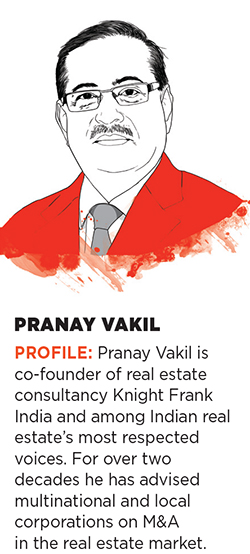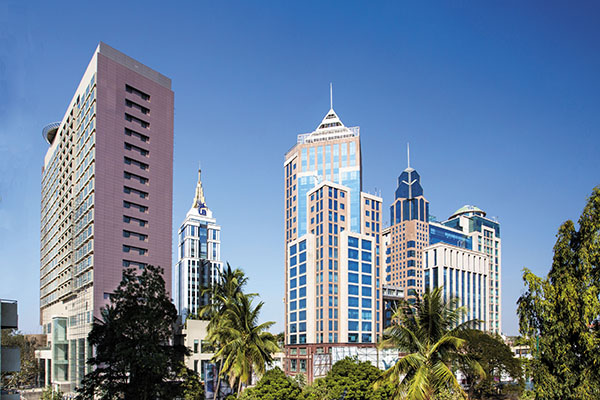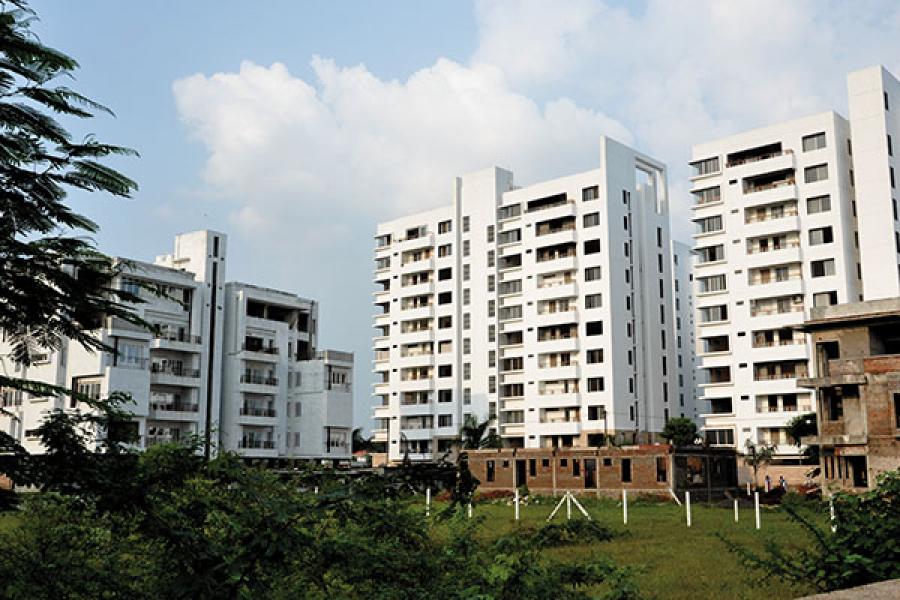
Real estate demand will come from second-time buyers: Pranay Vakil
The realty market may appear saturated but opportunities exist in new regions

Q. Over the last 20 years, real estate has yielded high returns, of around five times, in the top metros. Do you see that trend continuing?
Markets in the top cities may have peaked in terms of returns over the last 20 years, but that is not the end of the business. You are only looking at cities like Mumbai, but that is not the case in Ahmedabad where rates are still at Rs 3,000 per sq ft.
In Noida, too, you can make an investment. Most of the future growth is not in Mumbai or South Delhi where all the appreciation has taken place. You have to look at places like Vadodara and Bangalore as well.
Q. How will demand be created in tier I cities?
The demand will come from second-time buyers. It is important to distinguish between a first-time buyer and a second-time buyer. Today, the transactions taking place in the luxury and super-luxury segments are not from first-time buyers. They [the buyers] are selling one property to buy another. You are also looking at incremental costs for these second-time buyers. Say, I want to buy a luxury apartment (for Rs 10 crore) but I am getting Rs 5 crore for my existing flat. I’m looking for Rs 5 crore as incremental investment. How do I get that? I borrow Rs 3 crore. The balance Rs 2 crore I will draw from savings, etc. Ultimately, I will be putting down Rs 7 crore (5+2) plus the Rs 3 crore as borrowing. These kinds of structures have become very common in tier I markets. And as salaries grow and people who have made good returns on existing properties sell their flats, they will create the demand there.

The Bangalore skyline. The city still has affordable rates and is a good place to invest in
Q. Does it make sense to rent a flat in the city?
The wiser guys are staying on rent for Rs 30,000 or so in the central areas of cities like Mumbai. They are then deploying, or investing, surplus money into [cities like] Pune and Bangalore, or in towns where things are more affordable. As and when he decides to buy in Mumbai, he can avail of returns from these properties.
Take Ahmedabad, for instance. A major real estate group owned a property on a 200-acre land on SG Road. The initial buying price was Rs 2,200 per sq ft, which means a 1,000 per sq ft flat would cost around Rs 23 lakh. Today, in three years, prices have touched Rs 3,500 per sq ft. Our assumption is that the Ahmedabad property was an investment. If the investor had purchased three flats, he would have had a good return. And his ability to buy something in Mumbai goes up to that extent.
Q. In general, central Mumbai is capped in terms of appreciation unlike tier II and III cities. Don’t you think, to a certain extent, renting is a better alternative than buying property?
Do you fall in the category of a floating or permanent population? If I ask you to go to work in Hyderabad for one year, will you buy something there? The answer is no. You should not assume that 100 percent of the population in Mumbai wants to buy real estate. A working professional may have come from Delhi and wants to go back to her hometown. Around one-third of the total population of any industrial city is floating. Some may have a change of heart and buy [a property] where they move. But that typically happens after they have stayed in that city for a long time.
Illustration: Sameer Pawar
Q. Do you see the action shifting to the edge of the cities in India?
That is the case where all the real estate action happens. The Thane district near Mumbai is a prime example. Then we have Noida and Gurgaon with respect to Delhi. NH8 [the highway] changed these areas. And that is what is changing Mumbai and Delhi: Connectivity. In Mumbai it is the monorail, additional tracks and elevated transportation. The Eastern Freeway has opened up Chembur more than any other suburb in Mumbai. The prices in Chembur have risen from Rs 12,000 to Rs 17,000 in one year.
There’s also a cannib-alisation taking place: Something built as a highway is becoming a city road. To see this, you have to go to Pune. Every single building on both sides of the Pune Bypass Road is less than 10 years old. The four-lane highway [from Mumbai to Pune] has changed the entire concept of that 50-mile stretch. People are using the highway for community-building within the periphery of the city. They’ve also extended the Pune city limit to many villages. The case is similar with Ahmedabad. The two ring roads there have changed many things and far more emphasis is being placed on infrastructure.
The government wants to make Vadodara the cultural hub of India. From January 23-26, they are holding a fest called VadFest. The musician Yanni is performing against the backdrop of the Laxmi Vilas Palace. The event ends with AR Rahman; 40,000 people attending. A lot of people are flying from Delhi to Vadodara for it, which they’ve never done earlier. There will be night markets. Every single three- to five-star hotel is packed. As an investor, Vadodara is a good destination. Prices there will only rise.
Q. Which are the cities in India that you think people should be looking to buy as investors?
Right now, Bangalore is one of the best destinations because prices there are very reasonable. You can buy a reasonably good flat with even Rs 50 lakh. Surprisingly, Chennai is 50 percent more expensive than Bangalore for reasons nobody knows. With whatever is happening to Gujarat, I would like to advocate places like Ahmedabad for investment because you’re able to buy real estate at low prices.
Q. One rule that can help real estate investors?
One guideline is that you should always look at the selling price as a percentage of the land cost. If it exceeds 35 percent, then you should think twice [about buying]. All the speculation happens in land. Normally you can find out about land prices by looking at a ready reckoner. Prices are broken down by land categories: Residential, industrial and commercial. If you know the FSI applicable to a particular area, you will easily be able to calculate the current value of the land going backwards from the selling price.
If this exercise shows that the land component is less than a one-third of the selling price, the chances of you losing money is just not there—and that is downside protection.
When you are looking for property that will appreciate, it is important to look at the surrounding infrastructure and what is happening to that. For instance, in Bangalore, you have to select areas where infrastructure is being strengthened. It might even be on Mysore Road or Chennai Road. You’ll be surprised that Whitefield, which was so hot in Bangalore, has no longer remained that big a buyers’ destination. Reason: Because the connecting road between Whitefield and Bangalore city hasn’t stayed that good.
Illustration: Sameer Pawar
(This story appears in the 06 February, 2015 issue of Forbes India. To visit our Archives, click here.)
-
 Naresh Sharman
Naresh SharmanDear Sir, If I want to invest around Rs.50 Lacs. Should I be investing it in Pune Properties or Vadodara Property market. Kindly enlighten me with proper reasoning, understanding & clarity. Rgds Naresh Sharman
on Apr 12, 2016 -
 Aashil Patel
Aashil PatelThe second-time buyers are ever meant to be the investors probably. Comparing some metro cities that have already gotten saturation points within fluctuated time frame is an ideal trick when seeing great returns in yet-developing demography. Ever hiking property prices lead to more gains from rental properties, no doubt at all!
on Jul 7, 2015 -
 Akhil Joshi
Akhil JoshiThis is a great article. I have also observed this all over these years.This usually happens in multiple cities. real estate. i own plots in places like Baroda and Ahmadabad where the prices is not sky high unlike Mumbai.
on May 21, 2015 -
 Aaditya Singh
Aaditya SinghA nicely compiled article. The real estate sector is going through major changes with positive sentiments in the face of favourable economic environment and a bit of concern with a pile-up of inventory. I would suggest people to carefully examine project specifications and other related factors before investing in it.
on Apr 30, 2015 -
 Aaditya Singh
Aaditya SinghA nicely compiled article. The real estate sector is going through major changes with positive sentiments in the face of favourable economic environment and a bit of concern with a pile-up of inventory. I would suggest people to carefully examine project specifications and other related factors before investing in it.
on Apr 30, 2015















